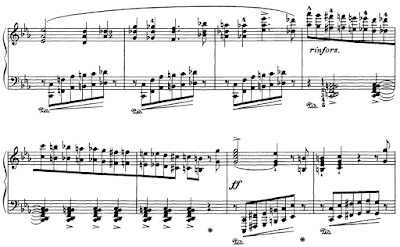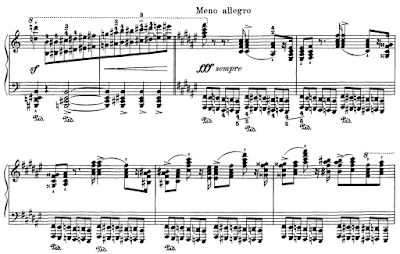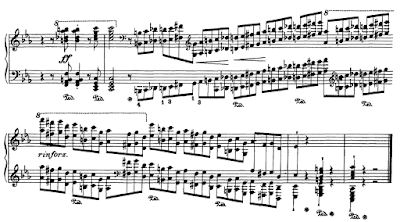Liszt, the famed virtuoso pianist and composer, informally known as the first "rock star," wrote a huge body of solo piano works. Among them include three years' worth of music while he went on a 'pilgrimage' to several European countries. As suggested by the title, the piece today is from his first year of pilgrimage in Switzerland.
This piece, Orage ("Storm") from Années de pèlerinage: Première année (Suisse), S.160, one of a set for solo piano, opens with fortissimo chords, voices jumping from the low end of the piano to the high end, interspersed with five-note chromatic rising figures, one which will appear several times throughout the piece.
This pattern repeats a few times before building up a wild rising chromatic passage in groups of four, with alternating rising and descending chromatically consecutive notes at tritones with each other, creating a brilliant dissonance as the notes reach the top of the piano.
With a torrent of sound, the notes fall to the bottom with thundering octaves, closing the introduction.
The first melody of the piece centers on the tonic of C minor at Presto furioso, which persists through most of the piece (only slowing for a still powerful Meno Allegro), with rising octaves in the left hand resembling the thunder of a storm, which breaks the traditional feel of the 4/4 duple meter of the piece.
The piece is riddled with dropping chromaticism in huge waves in the right hand (for example, from A5 and A6 to B4 and B5, a wide range to cover in under 3 seconds) and wildly dissonant chords in clusters in the left hand (for example a d°42 with a B♮, even marking it rinforzando at ff).
In between there are rising-falling figures in both hands in thirds, creating the effect of waves.
At Meno Allegro, Liszt adds rumbling low octaves with the Pedale to create a thunderous effect with a march-like melody above it in short grotesque interruptions...
...which quickly derails into a chaos of octave minor and diminished chords.
Before the Cadenza (ad libitum), Liszt includes an interesting figure. He starts with alternating octaves in alternating ascending and descending broken a♭°7, a°7, b♭°7, and b°7, followed by three ascending broken c°7, d°7, and e°7. This switch of first half-step skips to whole-step skips creates a rushed effect.
The Cadenza is preceded by a quick restatement of the opening figure with new mashed-up major thirds (they sound like major thirds but are written both as diminished fourths and major thirds).
The melodic contour and rhythm then underline a wash of up-down arpeggios in a classically flashy Liszt cadenza, which closes with more of those dissonant chords, mashing the keys at the highest and lowest reaches of the piano.
A reprise of the opening tumult and the first melody begins the coda of the piece...
...and then the melody begins to cool down, with the left hand retiring to arpeggios with single notes at a time rather than octaves, and the right hand moving slowly closer to the left down the range of the piano.
The left hand closes the phrase with a somber reflection of a previous figure.
The ending of the piece brings the listener back to the opening fortissimo chords, voices jumping from the low end of the piano to the high end, with those 5-note chromatic figures.
The piece ends with a tragic and violent flight up to the top of the keyboard hitting a record high A♭7 and tumbling down to C1 to finish off the “Storm.”
Thanks for following along! If you enjoyed this post, please share it! Leave your comments below and see you in the next one!
All score excerpts taken from the 1976 Neue Liszt-Ausgabe (New Edition of Liszt) by Editio Musica (Budapest) via IMSLP.org.
This piece, Orage ("Storm") from Années de pèlerinage: Première année (Suisse), S.160, one of a set for solo piano, opens with fortissimo chords, voices jumping from the low end of the piano to the high end, interspersed with five-note chromatic rising figures, one which will appear several times throughout the piece.
This pattern repeats a few times before building up a wild rising chromatic passage in groups of four, with alternating rising and descending chromatically consecutive notes at tritones with each other, creating a brilliant dissonance as the notes reach the top of the piano.
With a torrent of sound, the notes fall to the bottom with thundering octaves, closing the introduction.
The first melody of the piece centers on the tonic of C minor at Presto furioso, which persists through most of the piece (only slowing for a still powerful Meno Allegro), with rising octaves in the left hand resembling the thunder of a storm, which breaks the traditional feel of the 4/4 duple meter of the piece.
The piece is riddled with dropping chromaticism in huge waves in the right hand (for example, from A5 and A6 to B4 and B5, a wide range to cover in under 3 seconds) and wildly dissonant chords in clusters in the left hand (for example a d°42 with a B♮, even marking it rinforzando at ff).
In between there are rising-falling figures in both hands in thirds, creating the effect of waves.
At Meno Allegro, Liszt adds rumbling low octaves with the Pedale to create a thunderous effect with a march-like melody above it in short grotesque interruptions...
...which quickly derails into a chaos of octave minor and diminished chords.
Before the Cadenza (ad libitum), Liszt includes an interesting figure. He starts with alternating octaves in alternating ascending and descending broken a♭°7, a°7, b♭°7, and b°7, followed by three ascending broken c°7, d°7, and e°7. This switch of first half-step skips to whole-step skips creates a rushed effect.
The Cadenza is preceded by a quick restatement of the opening figure with new mashed-up major thirds (they sound like major thirds but are written both as diminished fourths and major thirds).
The melodic contour and rhythm then underline a wash of up-down arpeggios in a classically flashy Liszt cadenza, which closes with more of those dissonant chords, mashing the keys at the highest and lowest reaches of the piano.
A reprise of the opening tumult and the first melody begins the coda of the piece...
...and then the melody begins to cool down, with the left hand retiring to arpeggios with single notes at a time rather than octaves, and the right hand moving slowly closer to the left down the range of the piano.
The left hand closes the phrase with a somber reflection of a previous figure.
The ending of the piece brings the listener back to the opening fortissimo chords, voices jumping from the low end of the piano to the high end, with those 5-note chromatic figures.
The piece ends with a tragic and violent flight up to the top of the keyboard hitting a record high A♭7 and tumbling down to C1 to finish off the “Storm.”
Thanks for following along! If you enjoyed this post, please share it! Leave your comments below and see you in the next one!
All score excerpts taken from the 1976 Neue Liszt-Ausgabe (New Edition of Liszt) by Editio Musica (Budapest) via IMSLP.org.















No comments:
Post a Comment